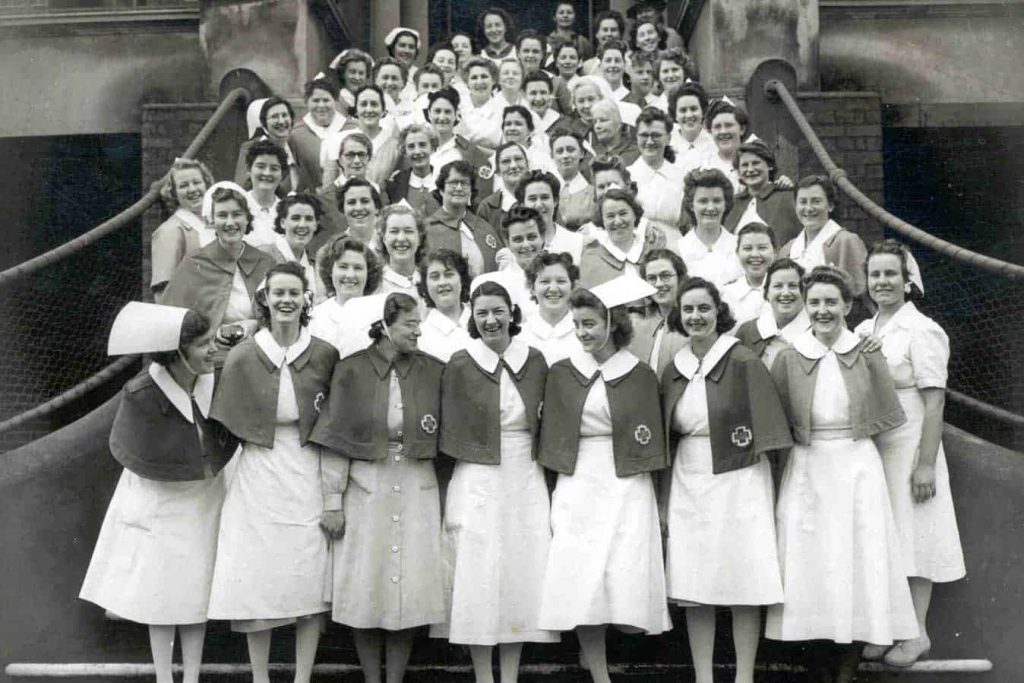Nursing uniforms have transformed dramatically over the past century on the back of emerging trends, demand for practicality and comfort, and strict workplace policy.
As a fledgling student nurse at Flinders University in South Australia in the late 1980s Kate Anderson remembers donning a yellow pinstriped dress and white stockings and shoes, all topped by a brown cape. (see photo above- left)
A red vest entered her daily work uniform a year later when she advanced up the ladder. “We used to joke that we looked like egg and sauce,” Kate laughs.
As a Registered Nurse Kate wore a characteristic white starchy dress with short sleeves and white shoes. “They weren’t very practical. They were see through and my pens always leaked into my pockets.” (see photo above- right)
Like most nurses, Kate’s work uniform has fallen in line with the trends and expectations of the period. In 1993, for example, she wore culottes, loose pants with flaps, and a white shirt.
Later, while working at a private orthopaedic hospital, the policy dictated staff wear straight skirts and a shirt coupled with navy shoes.
Health facilities invariably develop their own unique work uniform policies and Kate recalls being envious of Royal Adelaide Hospital nurses who at the time wore shorts and polo shirts on the job.
Kate says uniforms have come a long ways since the days of stiff, starchy white dresses. “It was always quite impractical what they made us wear but over time that has changed.”
Veteran Victorian nurse Barbara Hill wore a white button-up dress early in her career, and also remembers veils being phased out around the late 1970s.
She suggests every nurse retains a sense of pride each time they put on their uniform. “In many ways a nurse’s identity is wrapped up in their uniform. When you see a police officer they have a sense of standing in the community. I think it’s exactly the same for nurses. A uniform expresses pride and professionalism.”
Archives from the Royal Adelaide Hospital’s Heritage Office trace the evolution of nursing uniforms across the state and reveal noteworthy transformations. From 1890 to 1930, strict uniforms saw student nurses wear red and white, and matron and senior nurses don a dark coloured cotton material. A folded long rectangle cap was pinned to the nurse’s hair.

In the late 1930s, staff nurses wore uniforms made of blue and white check material, a button through shift dress with a belt, and white shank buttons from neck to hem. They also wore a red cape and white starchy cap with a deep turned-back brim. The nurse had a choice of wearing fawn stocking and brown shoes, or white stockings and white shoes. As the years have rolled on, nursing uniforms have changed with the times.
By the 1980s, nursing staff at the Royal Adelaide were wearing a variety of uniforms.
RNs wore a white dress with a zip or button fastening down the front, with three-quarter length sleeves and a white belt with buttons. A green velvet band was attached to the cap of a first year RN for identification purposes.
It is clear nursing uniforms have chopped and changed over the years, and even today different states, hospitals and health facilities stick to their own unique policies. However, the prevalence of scrubs in hospitals is on the rise and marks an emerging trend that could become the norm of the future.









13 Responses
I was the first female nurse at mint park psychiatric hospital to wear long pants ,the uniform reserved for men. The tailor seemed a tad uncomfortable taking my measurements!
Bring back those tall starched veils I say. You couldn’t work hands on in them but as the new Sister on the ward you just supervised everyone else.
I wore a green dress with white startched collar, cuffs & belt. Horrible brown Halls shoes with high clumpy heels. White startched cap. That was 1962. After graduating we wore blue startched dresses with white cuffs, buttons & collar. Then the large white vail.
Im still working part time & wear scrubs. The only drawback is patients don’t know who is who.
I don’t want to go back to the white starchy dress but oh my goodness can we please get rid of scrubs — These should be preserved for work in the OT and ED. Where is the professionalism and pride??
The starchiness of the blue dresses was gone by the end of the shift (Royal Perth 1972-75).
I loved my all white. It gave presence. Over the years I have enjoyed the changes to a more practical uniform and still take great pride in wearing a uniform.
I am not a fan of polo shirts they look to casual.
I began my nursing career in 1972 and was in the first PTS at my hospital to wear a zip up the front green number with attached white collar, brown stockings and Hall’s heavy duty nursing shoes. Prior to that the PTS’s wore the traditional checked dress with 50,000 buttons and the starched white cap.
Once we graduated we were encouraged to purchase the traditional white ‘sisters’ uniform with white stockings and shoes to match. How impractical was that!
Over the years, hemlines have risen then lowered and eventually I worked in a place where we wore culottes (navy) with an action-backed shirt (whatever that was)…. gradually evolving into navy pants and checked shirts a’plenty.
Nowadays, we wear scrubs, navy pants and coloured tops, pertaining to our logo of green and gold…
Things have certainly changed over the years…
How different it was for males back in the day….pants and top, pants and top, pants and top.
Now we all wear the same, males wear scrubs too and they are so preferable and practical for everyone.
I am still working (in my mid 60’s) and find today’s dress far more practicable than in those days of old.
The old uniforms are so professional. I love them.
Ann conn8ng feel free to wear that restrictive clothing but leave the rest of us out of it. Happy to wear scrubs.
At TQEH in Adelaide in the 1980s our student RN uniform was a purple dress with stripes on the left arm to designated year of training. We wore black shoes and stockings. We were also issued with a red cape – not sure I ever saw anyone wear the cape. Student ENs wore a blue uniform. Moved up to the white dress when I graduated. Left nursing before scrubs became common place but did get to experience culottes (navy blue) when I worked for an agency and these were much more comfy and practical than the dress.
Love the sisters’ white veils and the nurses with the little cuts in the top of their cap which represented which year they were in.
I meant to add – I was in hospital recently, and I went in very late at night and I had a question to ask, and didn’t ask, because I thought the only person in the ward was the cleaner and then by the morning, I realised that the woman was actually the nurse.
anyone who doesn’t like wearing scrubs is a boomer. Old ass honky uniforms making every nurse look like they work in a 50’s diner, no wonder no guys wanted to join.